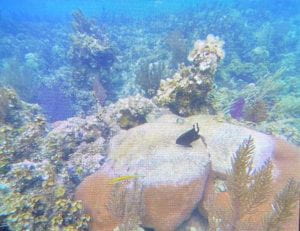Unfortunately, the day did not begin with urchins, but they will enter the scene soon, don’t worry!
We started off the morning by planning out another experiment. We knew we were going to be visiting preserved reef patches and non-preserved reef patches and collecting some sort of data with the quadrats, and that we would be doing urchin scavenger hunts. From there, we developed a research question that we could answer by gathering this data. We decided to investigate the correlation between live coral coverage and urchin prevalence, and how the amount of each changed between protected areas and non protected areas. We did not finish collecting data, so stay tuned!
Before we went out to the reefs, we waded in the sea grass bed and collected specimens to look at more closely in the outdoor lab. Some notable finds include a Caribbean spiny lobster, mantis shrimp, damsel fish, several varieties of crabs, lime urchin, anemone, corallimorph, conchs, and our favorite-brown algae! We found some sargassum natans, and some of the saucer leaf algae!
Afterwards, we went to the reef patches. We went to the non-protected area first to collect our data. It was difficult conditions, since the waves were strong and it was hard to stay in place. The urchin hunt was also difficult, since they like to hide in little burrows, so one could not easily get them out without harming them. We then went to the protected reef to snorkel for fun. Entering the protected area, I felt like I had died and gone to brown algae heaven (although maybe that wasn’t a great sign for the corals). There was saucer leaf algae, white scroll algae, and sargassum everywhere! They were intermixed with another type of algae, although I couldn’t identify it. The algae was growing all over the old, dead corals so densely I couldn’t even see the sand. Exciting stuff!
We also found a damsel fish garden, which was super cool. The damsel fish have little gardens where they cultivate their favorite algae, and protect it from other fish. And finally, the group spotted a lionfish, which was promptly speared (lionfish are invasive, and their capture is actually encouraged!) and brought aboard so we can use it for activities later this week.
When we got back, we counted, IDed, and measured the diameter of the urchins we collected, and then settled in for the night! Tomorrow, we are going to be collecting more data for our research, and maybe we’ll even have an answer. See you all then!
-Elena





…but like don’t cuz they’re invasive 🙁


 No spiders or corallimorphs, zoanthids, or anemones seen today
No spiders or corallimorphs, zoanthids, or anemones seen today